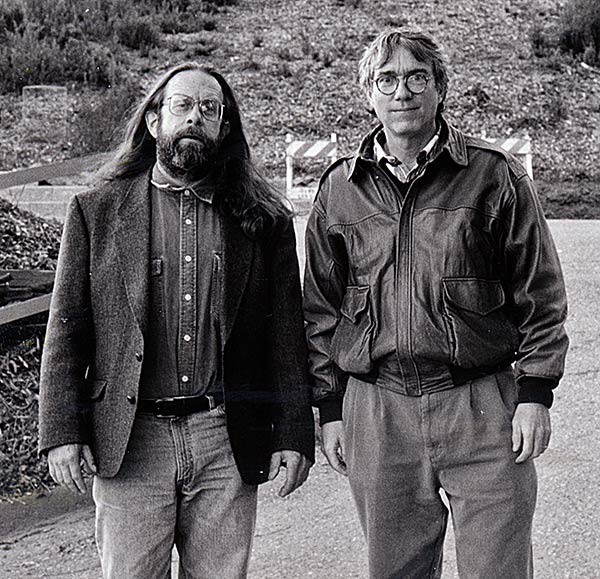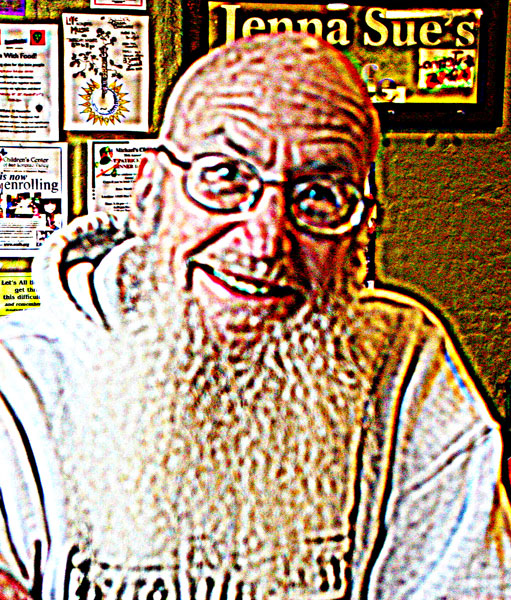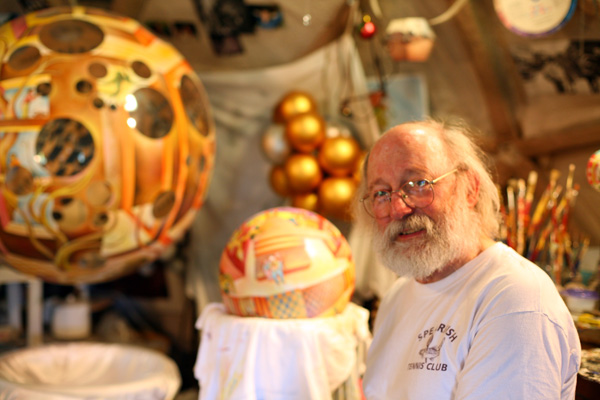
Saucer Wisdom
Paperback: Night Shade Books, March 2019, 4th Edtion, with a new, second introduction by Bruce Sterling.
Ebook: Transreal Books, 2016, 3rd Edition.
320 pages. Paperback ISBN 978-1-59780-965-8
See Rucker's other nine Night Shade books.
Buy the Night Shade paperback on Amazon or Barnes & Noble.
Buy the Transreal Books ebook (shown below) from Amazon or Transreal Books or Other Sites.

Reviews
We have seen the future and it crawls, swims, teems with billions of soft, sentient piezoplastic beasts --- a brave new biotech world where Rucker-revealed secrets of immortality, space travel and congress with aliens are as readily available as mushroom pizzas or a bigger hard drive. Saucer Wisdom soars.
--- Nick Herbert, author of Faster Than Light.
With Saucer Wisdom Rucker has reached a new peak. Saucer Wisdom is absolutely one of the best books of the year. Rucker has ... grown up, elucidating the wild-eyed, gonzo ideas of his youth with the clear-eyed, well-honed craft of a mature writer at his creative peak.
--- NOVA Express.
Groove to a mind-expanding leap into the future.
--- Publisher’s Weekly.
How delightful it was to open up Rudy Rucker’s latest madcap fantasy, Saucer Wisdom. Of all the new science-fiction writers, it is Rucker who most nearly approaches Dick’s imaginative mania.
--- Margaret Wertheim, The Australian’s Review of Books.
It’s brilliantly funny, prescient, and as fully engaging as a coffee-fueled late-night conversation with a slightly manic genius. From the aloof-yet-naughty aliens ... to the detailed, personalized visions of future people’s technology, Saucer Wisdom shines with a humanity firmly rooted right here on Earth... It seems that ‘the William S Burroughs of cyberpunk’ can’t help but write good books.
--- Amazon.com.
Generous, wild-eyed, yet sage ... The future envisioned here is one of liberating, near-utopian technologies that make the Extropians look like Alan Greenspan.
--- Isaac Asimov’s SF Magazine.
Saucer Wisdom is, first and foremost, a wild and exhilarating ride through the next 2,000 years of human history, throwing up enough bizarre concepts to sustain two or three careers of SF writing. What saves the book from overload is Rucker’s characteristically snappy, wisecracking style... Rucker is able to explain in witty and convincing ways just how most of the technological innovations he proposes would work, and --- unusual in futurist narratives --- he shows how these various technologies evolve. A pop-science book like no other.
--- Locus.
Rucker’s sensibility is a combination of gonzo humor, fictionalized autobiography in the Kerouacian mode (what Rucker calls “transrealism”), and the sheer, bugs-in-your-teeth thrill of scientific extrapolation taken to blitz-punk extremes.
--- Salon.com.
Notes, Illos, Browsing
Saucer Wisdom writing notes, a 50,000 word PDF document.
See an album of the fifty-seven full-size illos on Flickr.
Free online browsing edition of Saucer Wisdom.
From the Author
Saucer Wisdom arose from three interests of mine. First of all, I have a
lot of ideas about the course of future technology, and wanted to write a
book about that. Secondly, I'm very dissatisfied with people's current
ways of thinking about UFOs, and I thought it would be worthwhile to
write a novel which treats them in a more interesting and realistic
fashion. Thirdly, I like to write somewhat autobiographical books that
give "transreal" representations of various periods of my life.
So Saucer Wisdom features a main character named "Rudy Rucker." Rudy is
approached by a man named Frank Shook who's been frequently abducted by
flying saucers. But rather than giving Frank Shook medical exams and
lecturing him on world peace, the aliens have been showing Frank all
sorts of things about our future. Frank gets Rudy to help work his notes
up into a book, a book named Saucer Wisdom.
So, okay, fine, but how did I actually come to write Saucer Wisdom? It's a long story.
In 1996, my friend Mark Frauenfelder, editor of a zine (not yet a blog) called bOING bOING for
which I wrote a regular column, got a job as an editor at Wired magazine,
and then they put him on the staff their new line of Wired Books. They
had a lot of money and I had the idea of pitching a nonfiction book to
them. I wanted to write a book about fractals, chaos, artificial life,
cellular automata — my gnarly computer science interests, in other
words. But they thought this idea was too been-done.
In the meantime I'd written a column for bOING bOING #15 which had a
paragraph about a futuristic mind-recording device called a lifebox. So
Mark said, "Why don't you pitch us a Wired Book of future speculation
about stuff like the lifebox?" And I was into that. The close of the
millennium is clearly the time to publish a book of this type. And then
the editors were like, "There should be a frame for the future
speculation. I mean how do you know this is all going to happen. Should
you go to the future in a time machine?" And then I started thinking it
would be nice to have a UFO taking someone into the future. I'd always
wanted to write about UFOs, as I feel there isn't enough good SF about
UFOs. And I had certainly noticed Whitley Streiber's commercial success
with Communion. So it seemed like a good idea to write about abduction.
But rather than having me claiming be the one abducted, it would be
someone I knew.

Gregory Gibson as Frank Shook, posing with Rudy Rucker, February, 1997.
Meanwhile my old friend and fellow author Greg Gibson came to town. And I
had a pitch-meeting with Wired coming up. I got the idea that to really
clinch the deal, Greg should pose as my UFO-abductee friend. I had
already fixed on the last name of "Shook" for this character because when
I almost got drafted in 1967 there had been a hapless fellow conscript
called Shook, and that had stuck in my mind. And when I started talking
to Greg about having him pose as Shook, he said something about becoming
my Frankenstein's monster, so I then the first name had to be Frank. And
of course it makes a good sentence: "Frankly, I'm Shook."
So Greg and I went to the meeting, and to encourage Greg to come I said I'd pay him a small cut of my advance. Greg did a great job. He had long hair, and he's a
weathered-looking guy, like a Viet vet. He posed as a very nervous and
tetchy Frank Shook. And the two young Wired editors totally bought into
it. Midway through the meeting it "got to be too much" for Greg and he
stalked out. And for a few minutes the editors really didn't know if my
UFO abductee friend was real or not. And after a bit I let them off the
hook, and said, no, it had been an act. But they were dazzled and gave me
the biggest advance by far that I ever got for any of my books, fiction
or nonfiction. We were going to get my friend the underground cartoonist
Paul Mavrides to do the illos. I would do sketches of the illos and Paul
would redraw them.
The Wired Books editors were leaning towards promoting Saucer Wisdom as
really being true, doing the full Whitley Streiber thing and running it
as a media hoax. And then maybe in a year we'd reveal that it had been a
hoax, and get another little bit of publicity. I got more and more
uncomfortable with this notion. The idea of having to lie in interviews
made me uneasy.
Also I was having conflicts over whether I should really give
Greg a cut of my advance for the book. Greg was fully into the trip now, and he left some
disturbing messages on my answering machine pretending to be Frank Shook. Although I really didn't want to pay Greg, I gave him the cut I'd promised. But then I got so bitter about this, that a year later Greg gave me the money back. For him it was all kind of a joke, and I was taking it overly seriously.
The book had a tight deadline and I started writing it in a state of real
anxiety, in March 1997. I was getting off to a really weird start. As a way of transrealizing my turmoil about paying Greg, I had the book's character "Rudy Rucker" get into a quarrel about money with Frank Shook...and Frank seemingly steals Rudy's typewriter and his manuscript for the book.

Nick Herbert in Boulder Creek, 2009.
I was also becoming a little frightened of the whole UFO subject. To help get a handle on it, I spent some time with my science-writer friend Nick Herbert who
lives in Boulder Creek. Nick likes to theorize about UFOs. He was my second
Frank Shook inspiration, if you will. Nick and I talked about UFOs over
lunch at a restaurant called Adelita's in Boulder Creek, and this lunch
served as model for my lunch with Frank. Nick's house is not unlike
Frank's, although Nick's house is nicer.

Dick Termes in his studio, painting on spheres.
My third Frank Shook inspiration was my artist friend Dick Termes, not so
much for the way he acts as for where he lives, which is in North Dakota.
Dick lives in a dome-shaped house and paints on spheres, he's a
remarkable artist. In order to come up with a finale for the novel, I flew
out to visit Dick in North Dakota --- something I'd never done before,
but had always wanted to do --- and while I was there I drove from his
house to the Devil's Tower and spent a day there.
When I finished the first draft of Saucer Wisdom, in November, 1997, Wired suddenly folded their book division. I got to keep most of the advance.
But now it was hard to find a publisher for this odd orphan book. Finally
David Hartwell of Tor picked it up early in 1998 and I even got another advance.
I'd done the rough drawings for the book. I used to draw underground
cartoons for the Rutgers University newspaper in the early seventies, and
have always felt that I can draw, even though some might argue that I
can't. I do not try to draw like Thurber, by the way, it just happens to
look that way. Hartwell said something like, "Why not save money on the
project and use Rudy's drawings? They're lively and charming. They're
like the drawings a professor might put on the blackboard in a lecture.
And how technically proficient do they need to be, after all, if they're
supposed to be drawn by a guy who says he gets abducted by flying
saucers?" So I got some new pens and redid all the drawings pretty
carefully. Hartwell and Kathryn Cramer did some good editing of the text,
and I finished the illos and edits by Fall 98.
For whatever misguided reasons, in 1999 Tor and I chose to market Saucer Wisdom as a nonfiction book of speculations about the future. And it didn't sell very well. But, really it was a novel all along. A transreal novel about living in the San Francisco Bay Area just before the Millennium hit the fan.
And, as I mentioned, one of the main characters in the novel, the narrator, is a writer named "Rudy Rucker."
.
"Saucer Wisdom," painting by Rudy Rucker, oil on canvas, 1999. |